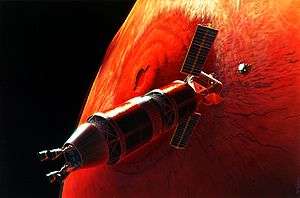Mars orbit rendezvous

Mars orbit rendezvous (MOR) is a space travel concept where two spacecraft meet up and/or dock in Mars orbit.[1] For example, one vehicle takes off from Mars, such as a Martian ascent stage, and does a rendezvous in Mars orbit with another spacecraft.[1] Applied to a Mars sample return or manned mission to Mars, it allows much less weight to be sent to the surface and back into orbit, because the fuel needed to travel back to Earth is not landed on the planet.[1] It has also been proposed for unmanned Mars sample return plans.[2][3]
In one mission proposal, MOR was planned for a Mars Descent-Ascent Vehicle (DAV) and Mars Transit Habitat, where a crew would transfer to the DAV after traveling to Mars on the habitat.[4] This allowed the Mars DAV to be launched separately from the transit habitat, and without any crew.[4]
MOR is analogous to Lunar orbit rendezvous (LOR) used on the United States NASA Apollo program missions to Earth's moon during 1969 to 1972, as opposed to Earth orbit rendezvous (EOR) or Direct ascent.[1]
A related concept is a Mars flyby rendezvous, where spacecraft do not enter orbit but rendezvous near the planet.[5] Mars flyby rendezvous was evaluated at NASA's Manned Spacecraft Center in the 1960s.[5] At that time NASA developed designs for a combination of a Mars lander, short-stay surface habitat, and ascent vehicle called a Mars Excursion Module (MEM); the ascent stage performed the rendezvous.[5] Compared to MOR, a flyby rendezvous means one spacecraft does not have to orbit Mars.[5]
Mars orbit rendezvous was utilized in Austere Human Missions to Mars, a tweak of DRA 5.0.
See also
- Mars Base Camp, a Mars orbiter station
- Manned mission to Mars
- Mars cycler
- Space rendezvous
References
- 1 2 3 4 Page 8-9 in Chapter 2 of David S. F. Portree's Humans to Mars: Fifty Years of Mission Planning, 1950 - 2000, NASA Monographs in Aerospace History Series, Number 21, February 2001. Available as NASA SP-2001-4521.
- ↑ Mars Sample Return: The Medium-Lift Approach, Morris Jones, Sydney - July 1, 2000.
- ↑ Mars Orbit Rendezvous Strategy for the Mars 2003/2005 Sample Return Mission, DAmario, Louis A.; Bollman, Willard E.; Lee, Wayne J.; Roncoli, Ralph B.; Smith, John C., Technical Report, Jet Propulsion Laboratory, California Institute of Technology, 1999-02, accessed 2010-09-16.
- 1 2 Hoppy Price - Austere Human Missions to Mars (2009) - JPL
- 1 2 3 4 Portree, David S. F. (February 2001). "Chapter 3: EMPIRE and After". Humans to Mars: Fifty Years of Mission Planning, 1950 - 2000 (PDF). NASA Monographs in Aerospace History Series. National Aeronautics and Space Administration. pp. 15–16. Retrieved July 18, 2014.
External links
- Mars Orbit Rendezvous Strategy for the Mars 2003/2005 Sample Return Mission (The Smithsonian/NASA Astrophysics Data System)
- Max Faget's Mars mission proposals